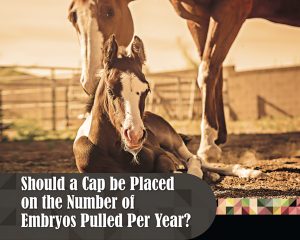Should a Cap be Placed on the Number of Embryos Pulled Per Year?
Click here to read the complete article
The practice of pulling embryos from celebrated show horses has become a routine part of our industry–both for the retired mare that can no longer carry a foal and for the mare that’s currently still being shown.
According to Colorado State University’s Dr. Patrick McCue, “Embryo transfer involves the removal of an embryo from the uterus of one mare and the transfer of that embryo into the uterus of another mare.”
Since embryo transfer produced the first foal in 1974, technology has advanced to make embryo transfer more available. The ability to continue the show career of a renowned mare, while still being able to produce multiple embryos during the same year is a remarkable benefit.
However, there is always the possibility of having too much of a good thing, and there are potential downsides to what’s currently an unlimited practice.
Influencing the Gene Pool
If a mare can produce six to eight embryos in one year, that could potentially result in the same number of registerable foals, if all goes well. Some believe this could have an impact on a breed’s population over time.











